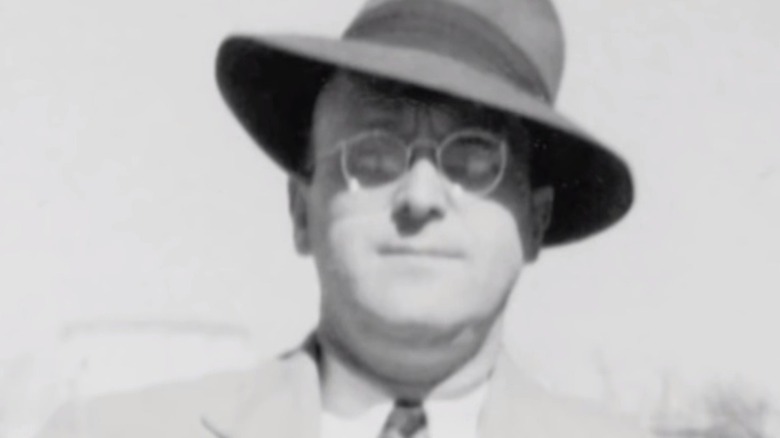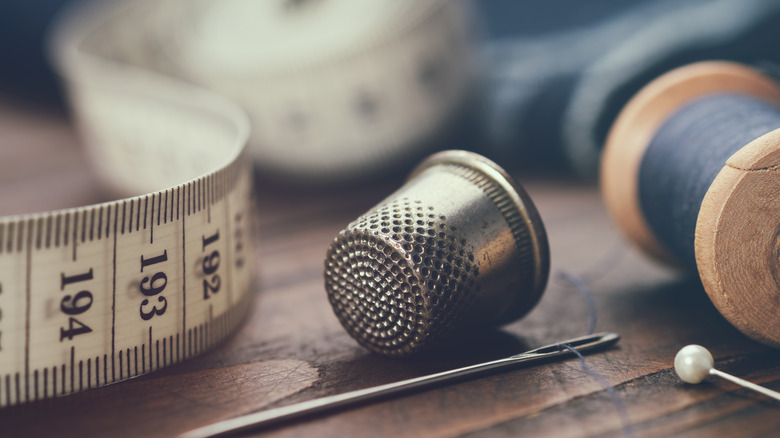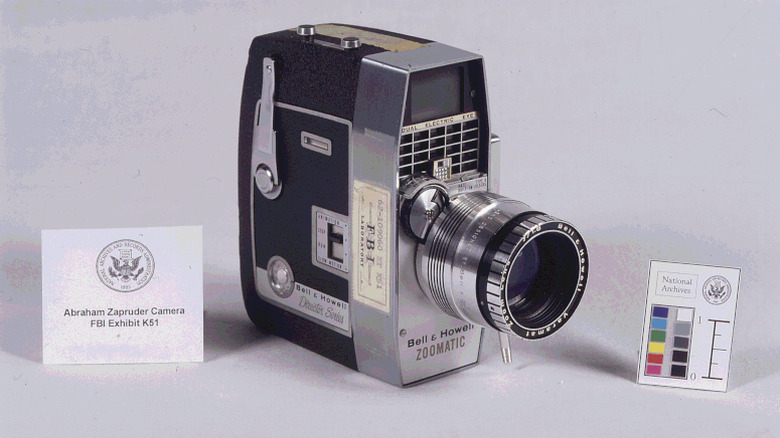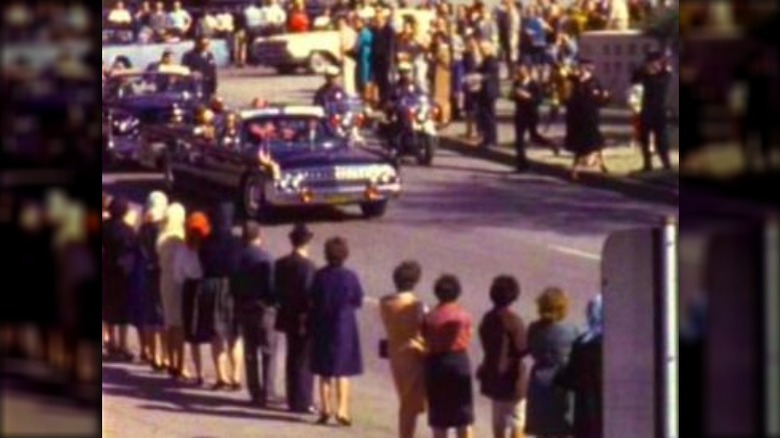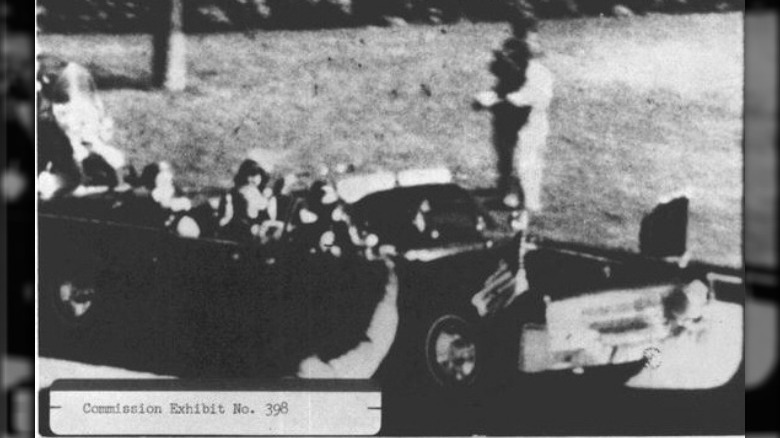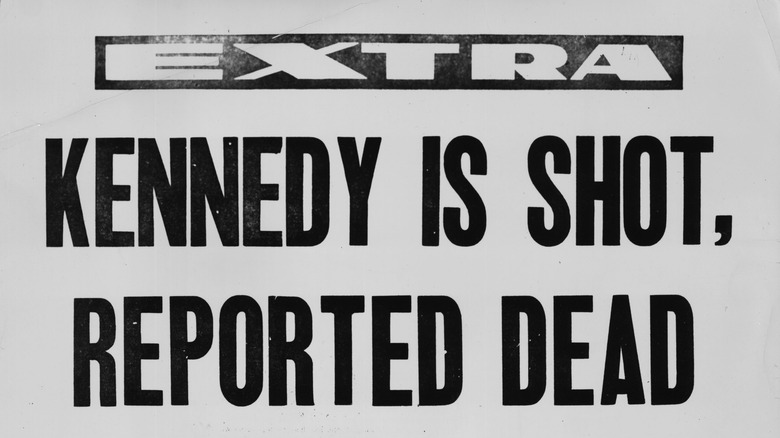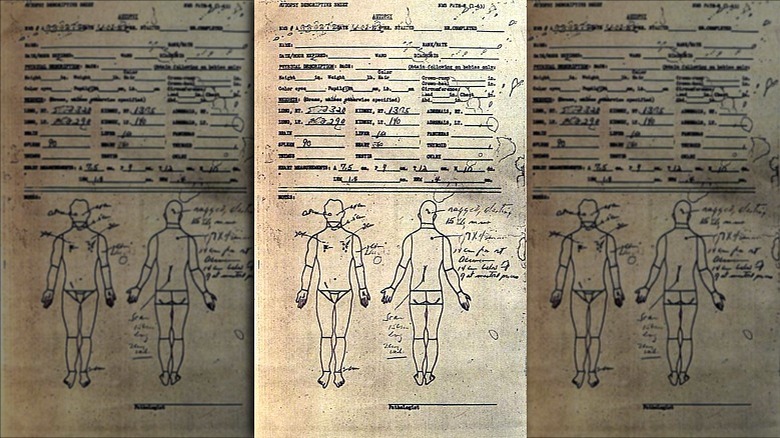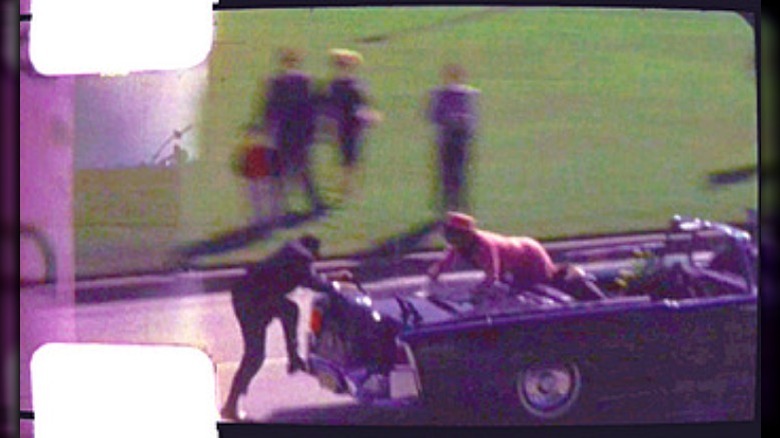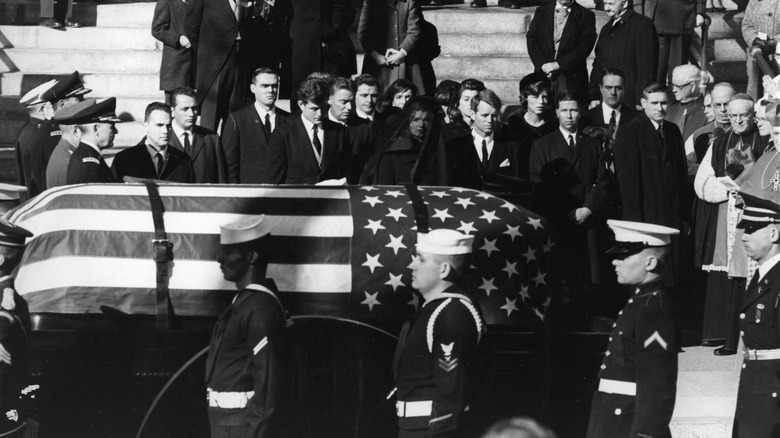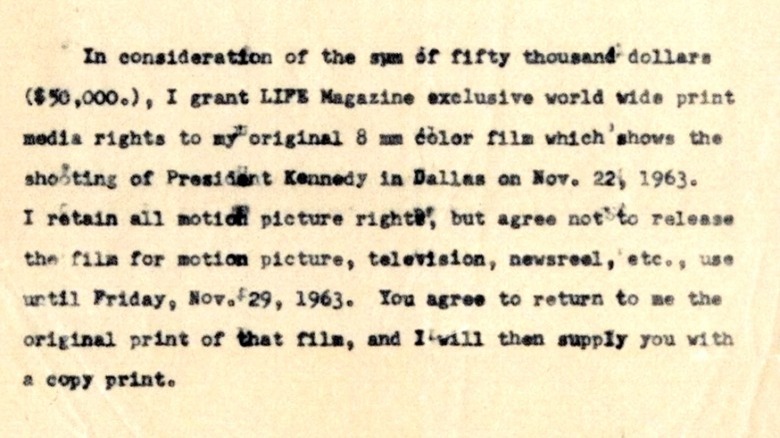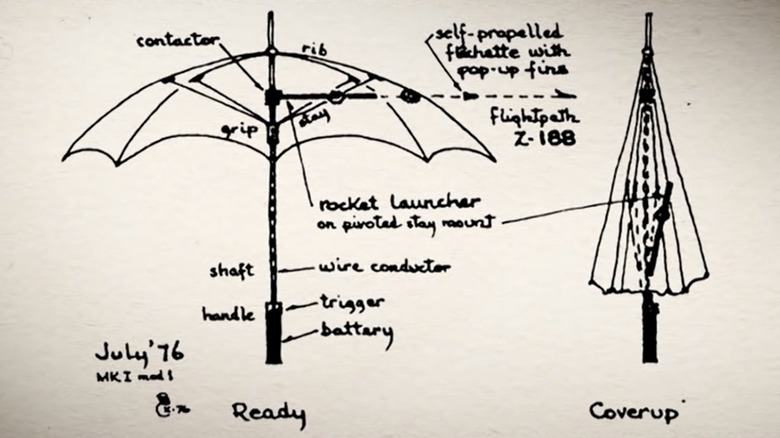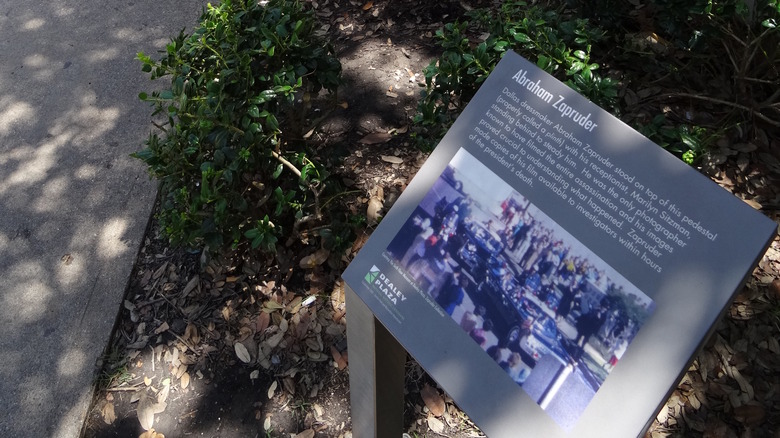Abraham Zapruder: The Man Who Captured JFK's Assassination On Film
The John F. Kennedy assassination. It's famous and tragic, and also chock-full of conspiracies. Seriously. There are a ton of these, many of them even wilder than the last. Inside jobs, deals with the Soviets, an umbrella fitted with a secret CIA-grade dart launcher — it's all out there. And a lot of those theories — a lot of that speculation — comes from something called the Zapruder Film. At 486 frames long and just over 26 seconds in duration, the film taken on November 22, 1963 in Dealey Plaza is the only one to capture the entirety of the Kennedy assassination, from beginning to end. Studying that film down to the smallest detail has given scholars and conspiracy theorists alike so much to sink their teeth into, with many of those theories still being talked about to this day.
But if you start peeling back the curtain, there's more story there than just the crazy conspiracies. There's the man who actually captured that film: Abraham Zapruder. He was 58 years old at the time, a Russian immigrant and dressmaker working in Dallas. A beloved boss and family man, Zapruder just happened to cross with history by complete chance, though it ultimately changed the fate of his family for decades to come.
Abraham Zapruder was in the dressmaking business
In a lot of ways, Abraham Zapruder really didn't seem like the kind of man whose name would be so tightly tied to such a dark moment in American history. Alexandra Zapruder described her grandfather in her memoir "Twenty-Six Seconds: A Personal History of the Zapruder Film." Born in Imperial Russia to a Jewish family, Abraham was intensely curious, having the mind of an engineer, and wishing for more than his circumstances could provide.
Fortunately, his family emigrated to the U.S., and there, he learned the "needle trades" in New York and entered the clothing industry, which he stayed in for decades. Eventually, he ended up moving to Dallas to keep working in the garment business, which was where he ultimately owned his own dressmaking business, called Jennifer Juniors.
Abraham was really good at his job, having an innate sense of style and exquisite taste. (He and his wife Lillian apparently made a very stylish couple.) Between the two of them, his wife knew how to shop smart and save money; they would buy dresses from more expensive shops to use as templates, then return them for a refund. And Abraham just had a trained eye for what looked good, knowing better than most how to play with fit, fabrics, patterns, and embellishments to improve on designs. As a boss, he was much loved, too, doing well to cultivate a sense of family and trust among all the people who worked for him.
Home movies were a hobby of Abraham Zapruder
In a lot of ways, this one makes a lot of sense. After all, just think about it: the Zapruder Film is, at its core, a home movie of a president riding through a man's hometown. It just so happened that the event ended in tragedy, but that doesn't change what it started out as.
Abraham Zapruder was known by everyone around him as someone who loved making these home movies and films. Alexandra Zapruder recalled that fact in "Twenty-Six Seconds: A Personal History of the Zapruder Film," saying that her grandfather had been making home films of just about everything for decades — from the 1930s onward. The interest had initially started with still photos — ones of his wife, which he would develop himself. It was just something he loved, and the passion ended up shortly transitioning into shooting films.
Those videos were really close to the home movies that a lot of people are probably familiar with. Videos of the family, of the kids as they grew up, and videos of his own parents and the places he'd seen change through the years. It's such a normal sounding hobby, and maybe surprisingly so, considering what would come of that amateur filmmaking. But in actuality, the original film developed which included the assassination had more than just that. It also had footage of Zapruder's grandkids playing, as well as a few of his employees just enjoying life.
Abraham Zapruder is much more than just the Zapruder Film
Because of how history tends to work, the name Abraham Zapruder is pretty much just tied up with the story of the Zapruder Film, tied up in the tragedy that surrounds the Kennedy family and the assassination of JFK in particular (via NPR). That's all that most people really know, because it's the part that really holds the public's attention. But here's the thing: Abraham Zapruder was also a real person, not just a name attached to this widely analyzed historical document. Mr. Zee, Papa Abe — that's how he was better known to people who were actually close to him.
So, according to "Twenty-Six Seconds: A Personal History of the Zapruder Film," the Zapruder family hasn't really liked to talk about the film and its history. It kind of flattened out the man who was known by his family for laughing at his own bad jokes he would make to his kids, or for constantly tinkering with the electronics in the house to the point that they feared the doorbell would explode. He wasn't known as this warm human being; he was just known for being the guy who happened to record Kennedy's assassination.
And that notion has been upsetting to the family, because Zapruder "should have been famous for who he was, for being a good person and a funny, wonderful man, and not for the film." They would rather remember him for who he actually was.
The Zapruder Film almost didn't exist
For as famous (or infamous, depending how you look at it) as this film ended up becoming, it actually almost didn't exist at all. Or, at any rate, Abraham Zapruder himself didn't really have any intention of capturing any film on that day.
According to "Twenty-Six Seconds: A Personal History of the Zapruder Film," everyone in Dallas knew that the President's motorcade would be passing through. On the morning of, a handful of Zapruder's staff asked him whether or not he'd be taking a film of the parade, knowing his love of home movies. To their surprise, he told them that he wasn't — he hadn't even brought his camera. Described in the memoir as practical to the point of pessimistic, he didn't think that he stood any chance of getting good shots, what with the huge crowds. Everyone around him knew that, in the future, he'd regret passing on the opportunity and managed to convince him otherwise. There was some debate on it, but eventually, he was convinced and got his camera.
But that's not all. In his own testimony, Zapruder mentioned that he'd originally planned to shoot the video from a different area: up in a window (actually, the building right next to where Lee Harvey Oswald had shot from). He ultimately changed his mind, heading down to the street for the chance of a better view, but had he not changed his mind, the famous film wouldn't have been the same.
Abraham Zapruder was the first to know the truth
In the frenzied aftermath of the shooting at John F. Kennedy's motorcade, no one was quite sure what exactly was going on. The spectators had all just heard the gunshots, but beyond that, nothing was certain. People couldn't know that November 22, 1963 would be the day of the JFK assassination. So after the shots fired, the motorcade was whisked away, and the bystanders were left in the dark. Eventually, news started going out that the president had been taken to Parkland Hospital. There weren't many more details beyond that, and, per Zapruder's own testimony, no one seemed to know Kennedy's condition.
Well, everyone except Abraham Zapruder. Yeah, Zapruder ended up in the really unenviable position of probably being one of the first people to know that the President had been assassinated right in front of the public's eyes. He had the right angle to witness everything, and a camera with a fully zoomed-in lens (via "Twenty-Six Seconds: A Personal History of the Zapruder Film"). He'd been able to see all of the details in real-time, knowing immediately that Kennedy had been shot in the head, because he literally couldn't have missed it.
And to really show just how stark that difference was, by the time he returned to his business, his staff was trying to reassure him that the president was taken to the hospital. All the while, he was responding with the actual truth. "They killed him, they killed him."
Abraham Zapruder didn't want frame 313 getting out
By this point, were you to go and look up the Zapruder Film, you'd be able to find the full version of it pretty easily. All 486 frames, all 26 seconds — they're all easy to get your hands on. That wasn't always the case, though, and the reason is frame 313. But this is a video of a presidential assassination, right? What makes this one frame so special?
Well, frame 313 was withheld from the public, and for a pretty long time — about 12 years, according to the Washington Post. On top of that, it was done by the request of Abraham Zapruder himself, who said that this one frame in particular was enough to give him nightmares. In his own testimony to the Warren Commission, he remembered that specific frame, just calling it "the horrible one," and for over a decade, magazines would honor his request, with the full film — frame 313 included — not being shown to the public until 1975.
Alright, but what was it about this frame that was so terrible? Frame 313 depicts the moment that Kennedy was shot in the head. We're not showing it above because, well, you can see his head basically explode, pieces of (what some believe to be) his skull going flying in the carnage. It's a terrifying single image, and one which filmmaker Errol Morris told Smithsonian Magazine shatters your sense of security. Seeing that exact moment of the assassination — it's burned in your brain.
Abraham Zapruder did what he could to help
In the aftermath of the assassination, Abraham Zapruder seemed pretty aware that he had something really valuable on his hands. But "value" in monetary terms didn't really seem to be his main concern, at least if the reports are correct.
"Twenty-Six Seconds: A Personal History of the Zapruder Film" talks about the chaos that circled Dealey Plaza after the shooting, and that Zapruder was pretty shortly approached by reporter Harry McCormick for the Dallas Morning News. McCormick had noticed Zapruder's camera and wanted details, only for his request to be shot down. Zapruder wanted to talk with the federal authorities and was determined to make sure they got a copy of the film; luckily, McCormick offered to get him into contact with the chief of the Dallas Secret Service. Another reporter — Darwin Payne — also tried to get his scoop, but in the end, both he and McCormick were left out of the room when Zapruder spoke with the Secret Service (via The Sixth Floor Museum at Dealey Plaza).
In his testimony to the Warren Commission, Zapruder also mentioned that he gave his camera over to the FBI to help them in their investigation. They offered to reimburse him for it, but he refused, asking them to donate something instead. He didn't want anything for himself, adding that, should the authorities want any more help from him, he'd be glad to go in and offer whatever services he could.
The whole ordeal was hard on Abraham Zapruder
Maybe this point really isn't all that surprising, considering everything that had happened — all of America was in mourning after the Kennedy assassination, after all. But it still seems important to bring up nonetheless, because Abraham Zapruder was also a person living through this time, not the just name attached to a film.
In the moments after the shooting, Zapruder was completely stunned. As "Twenty-Six Seconds: A Personal History of the Zapruder Film" paints it, he could hardly believe what he'd seen. It had to be a joke or a prank; something this horrific and barbaric couldn't take place in America. But it had, and after the film was developed, Zapruder and his family ended up watching the tragedy on film, watching it all with a sort of shocked numbness, knowing all the while that there was so much that they would have to deal with, between legal rights and potentially keeping this grief alive by capturing it on film.
Because now, Zapruder was at the center of all of this, and his grief was easy to see. An interview with WFAA-TV left him too distressed to really talk about what he saw (via ABC News), and he actually broke down on the stand while testifying to the Warren Commission. He'd loved Kennedy, and seeing him killed left a "very, very deep sentimental impression," one that made it too hard for him to recall the moments after the shooting without crying.
The Zapruder Film went to a couple different places
Given Abraham Zapruder's insistence that his film be given to the Secret Service to help out in the investigation of the Kennedy assassination, obviously, a couple of copies made it into the hands of the authorities. That's part of what allowed the Warren Commission to study the assassination in detail (via The Sixth Floor Museum at Dealey Plaza). Those particular copies would ultimately, though, live on heavily through conspiracies and theories about a cover-up, as The Guardian explains — doctored footage, omitted and reordered frames in reproductions made from those copies didn't inspire confidence.
But the film also eventually made it to the public through LIFE — specifically, through Zapruder's close working relationship with one of LIFE's editors, Richard Stolley (via "Twenty-Six Seconds: A Personal History of the Zapruder Film"). That relationship allowed Zapruder to have some say in just how the film would be distributed — namely, he didn't want it to be "exploited." Eventually, LIFE also purchased TV and movie rights to the film for a price of $150,000.
It's worth mentioning, though, that Zapruder didn't actually keep all of that money. In his testimony, he explained that he donated the first $25,000 of that to the Firemen's and Policemen's Benevolent Fund. More specifically, it was meant to go to one Mrs. Tippit, whose husband, Officer J.D. Tippit was killed while trying to stop Lee Harvey Oswald less than an hour after the assassination.
The Zapruder Film spawned conspiracy after conspiracy
It doesn't seem at all necessary to explain just how many conspiracies surround the JFK assassination. While just about any major historical event has its own share of conspiracy theories, this particular one just has so many, and a decent number of them spawn from the Zapruder Film.
The Washington Post mentions a few of them. The Umbrella Man theory, which involves a man with a black umbrella, standing right in front of Kennedy at the moment he was shot, who just happened to make it into the film. The multiple gunmen theory, which believes that Lee Harvey Oswald didn't act alone, is based in part on the spray of blood as Kennedy was hit by one of the gunshots. Or the idea that it might've been an inside job, with the driver seeming to reach back and shoot Kennedy himself, at least in low-quality versions of the Zapruder Film (via The Washington Post).
Granted, some of those conspiracies have been debunked. Louie Steven Witt — the Umbrella Man himself — testified that he had nothing to do with the assassination, and the driver was shown to not actually be holding a gun. (The multiple gunmen theory is technically still on the table, though.) Nevertheless, as The Guardian says, the fascination with these conspiracy theories lives on, with documentaries and films still being made to this day, just to keep examining the assassination and the Zapruder Film.
The Zapruder Family has had to deal with a lot because of the film
As Abraham Zapruder's granddaughter, Alexandra explained in her memoir, the impact of the film on the family hasn't been great. They avoided talking about it, trying to just be a normal family. With their name being as recognizable as it was, though, people would ask questions, which left them to try and politely shut down any of those conversations. Plus, they've basically had to continuously deal with legal and financial details of the film and its ownership.
Decades and extensive legal issues later, an arbitrator demanded $16 million for the family, saying that the Zapruders still owned the film, but that the government had taken in from them; of course, the rest of the public had to have their say, with people suddenly trying to weigh in on things like their moral character (via The Miami Herald). To people looking in from the outside, it just looked like greed, like the family was trying to profit from tragedy.
That wasn't true at all, though. Abraham Zapruder had actually been really uncomfortable with that idea from the start, and the family later set such a high price because they had hoped the government would just drop it, allowing the film to stay in the National Archives, "where people could see it but it couldn't be mass-marketed." Obviously, things didn't go that way, and the media had a field day trying to drag their name through the mud.
